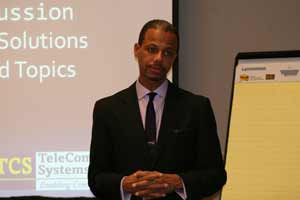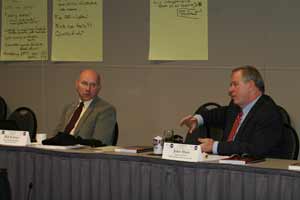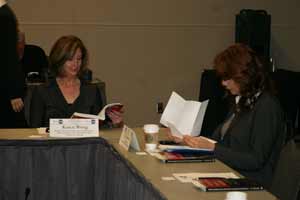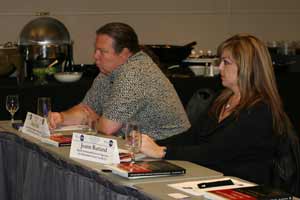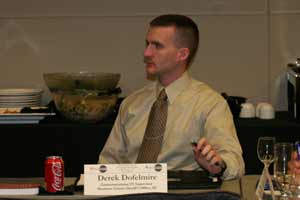Thoughts from Around the Room
What can a small group accomplish? For APCO International, its inaugural Technology Roundtable, held Feb. 9 in Ontario, Calif., and sponsored by TeleCommunication Systems Inc., succeeded in creating an open and dynamically evolving dialogue among 13 public safety communications leaders on the topics they wanted to discuss.
This event was designed to spark constructive conversations about important topics, identifying and understanding problems and their barriers, and brainstorming solutions. In his introduction APCO Executive Director George S. Rice Jr. said, “This is our very first foray into the Technology Roundtable format, an event specifically designed to be intimate in its nature so that we can share a few thoughts, maybe work through a few problems, and find some solutions along the way. It will be very loosely scripted; it will be organic. … This is your forum”
This week’s group brought together RF engineers, IT professionals and operations experts with backgrounds in all the various public safety disciplines. Prior to the meeting, participants submitted approximately 15 topics of interest that made up an agenda that was not followed.
Bill Schrier, chief technology officer for the city of Seattle and chair of the APCO Broadband Committee, was tasked with moderating the event. After pulling up his PowerPoint presentation, Schrier made it clear that he was just posing his ideas and preconceived notions for conversation about two specific technologies and their effects on public safety. Throughout his “presentations,” participants asked questions, steering the conversation as they went.
Wireless Broadband Data Networks
Schrier began by making two assertions: 1) “There will be a nationwide responder network in the next 10 years. We will do it.” 2) “The network will fundamentally change delivery of government services on the ground.”
He emphasized “responder network” because first responders, secondary responders and the services that support them will need access to the network. The network may also enable other government departments to conduct business differently, while still supporting public safety.
He noted that the Los Angeles Regional Interoperable Communications System (LA-RICS) will have such a network in approximately three years. Note: This program received a $154 million grant from BTOP (Broadband Technology Opportunities Program), which is currently funding seven of the 21 public safety entities that received an FCC waiver to begin building out a wireless broadband network in public safety’s 700 MHz spectrum. These waivers were granted on the specific grounds, such as the networks using LTE (long-term evolution) technology. To aid public safety in building a nationwide interoperable broadband network, the Obama administration [https://psc-legacy.apcointl.org/2011/02/10/president-obama-details-plan-to-win-the-future-through-expanded-wireless-access/] has come out in support of reallocating another 10 MHz of spectrum in the 700 band (the D Block) to public safety. BTOP requires that the networks be working by 2013.
These networks will add the transmission of such data as video back to the comm center. According to Schrier, broadband networks currently support data (e.g., photos, video, building plans) and will soon support cellular voice — and in a much longer term they might support voice dispatch.
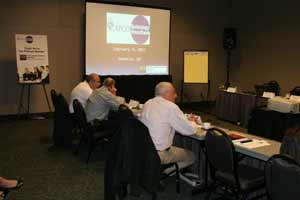
From left: Roundtable participants Joe Acosta, Richard Granado and Mark Pallans socialize before the meeting begins.
Seattle has also applied for BTOP funding for its network. Fiber is currently installed in every school and state or federal building in the city. With this network, 40 LTE cell sites can be established to build the broadband network. It has to have the ability to roam to public safety networks. The intention is to run more fiber into public housing and also brig in Internet access. Schrier said, “Anybody know what the problem is? We didn’t get the BTOP, so we are currently unfunded. I have about $5 million, and this is a $24 million project.”
Richard Granado, who is retired from the LA County Radio Division, pointed out that fiber is great, but in congested areas without a similar network, it would be very difficult to get the bandwidth to transmit broadband data.
Schrier said that the city would rather build its own network. In the area, Verizon currently has its own LTE network that has no public safety priority. The city is looking to expand the network to cover the county and eventually the state.
To fund the network, Schrier has been advocating bringing secondary responders onto the system to expand the use of the network and number of subscriber units, and also help fund the maintenance and ongoing operational costs of the LTE network.
But according to the FCC waivers, the systems can only be used by public safety. Does that include public utilities? Many participants voiced that such departments are part of public safety at times. Karen Wong, deputy director of public safety communications for the Office of the California State Information Officer, noted that many dollars are spent duplicating efforts.
“The difficulty with LTE is that the coverage site is going to be smaller,” says Schrier. “Shear number of sites for coverage is going to be an issue of LTE.” He pointed out that the same terrain in Seattle is currently covered by only seven land mobile radio sites. It was also noted that LTE may never be airborne, which is a potential problem.
Social Media
After the first break, Schrier tackled to topic of social media and its use in response. Schrier’s assertions: 1) “Social media have fundamentally altered society on planet Earth and will continue to do so.” He pointed to the current events in Egypt and Tunisia to support the statement. 2) “Social media will significantly alter the relationship of government and responders to constituents.”
He specifically discussed how the city of Seattle is using platforms like Facebook, Twitter, blogs and YouTube to engage the public and keep them informed. Many of the departments serving Seattle are engaged in a one-way conversation with the public. The only page that allows comments from the public is the mayor’s Web site. The city has developed policies for using social media, what can be posted and what must be removed from a police report before being posted. In many cases, the PIO posts links to a report on Twitter or Facebook. But some of the system is automated.
For example, the Seattle Web site has a feature called “Mash Up,” which allows the public to view the location of calls for service in real time. The CAD and RMS systems integrate with the Web technology to allow this level of public access. The only exception is police reports, which take from eight to 72 hours to post police incident reports.
Mark Hill, communications engineer/administrator for Gila River Indian Community, pointed out that they use a service called NIXLE to push information out to the media and the service’s other local subscribers via SMS (short message service) and mobile applications. NIXLE is currently free for public safety entities.
For many of the participants, this level of public access could have liability issues for the city or an agency. Schrier stressed that thorough policies need to be written and that Seattle has not had any issues arise.
NG9-1-1
Next Generation 9-1-1 (NG9-1-1) was selected as the last topic of discussion for the day. To facilitate the conversation, John Hunt, director of NG9-1-1 for TeleCommunication Systems Inc. and a member of Illinois State 9-1-1 Board, agreed to give a brief overview of his Feb. 8 presentation, “Gaining Perspective on Next Generation 9-1-1.”
Hunt briefly defined NG9-1-1 as “moving from the legacy analog 9-1-1 system that has served us well for the past 35 years, and is all based on old telephone technology, into the 21st century. Things that not only the public [is] accustom to using with their mobile devices today. The technology itself is not new, the application for public safety is new. … It’s end-to-end Internet protocol technology.”
Hunt stated, “There really is not today a working model for receiving a text in a PSAP and having the ability to do tow-way communications. There is a situation in the state of Iowa that has been around for a couple of years, but for all intensive purposes, it really is just a lab-type setup, not a real-world, live application.”
The hottest topic on NG9-1-1 became how to fund it, particularly when some areas of the U.S. have no 9-1-1 systems penetration and while the migration to wireless 9-1-1 calls has meant ever-decreasing revenue from 9-1-1 surcharges around the country. The group’s consensus was best stated by Derek Dofelmire, APCO Executive Council representative for the state of Idaho, “9-1-1 is something everybody wants, but no one wants to pay for.”
According to Hunt, the public safety communications community is going to have to start thinking outside the box on 9-1-1 funding and cannot expect — or wait for — the federal government to step in to enact a federal 9-1-1 surcharge.
He said, “It may be impossible to find this person, but we need to find someone at the federal level or state level, a brave legislator that will take the issue [of 9-1-1 funding] and run with it. … It may take something really radical … let’s get away from the surcharge.”
As an example of this radical thinking, Hunt suggested that it could be conceivable to double a tax on alcoholic beverages to pay for public safety. “It was stated earlier that you need to tie the surcharge into the service, well, I would say that alcoholic beverages play a role in a lot of accidental crime. Those are the kind of things, short of getting a legislative champion who will take this whole tax issue and run with it and make the argument, and I believe it’s a compelling argument, that everybody relies on 9-1-1 service, but nobody wants to pay for it. There are a lot of opportunities out there; we’re going to have to be creative.”
Next Steps
Other topics hit on during the event included the future of the P25 (Project 25) standard, establishing radio coverage in complicated terrain, automatic call units, mobile communications vehicles, interoperability and narrowbanding.
APCO International and the participants in Ontario will keep the conversation(s) going. Participants will be able to connect and exchange ideas and information in a private forum on PSConnect, as well as participate in a roundtable reunion that will bring together participants from all four events at the 2011 APCO Annual Conference & Exposition in Philadelphia to both exchange ideas and make connections. To ensure their attendance, all roundtable participants will receive a complementary registration for the conference.
Join the next conversation: The next APCO International Technology Roundtable will be March 22-23 at the Minneapolis City Center Marriott. Visit http://roundtable.apcointl.org to learn how you can become involved.
About the Author
Natasha Yetman is associate editor for APCO International’s Public Safety Communications magazine. Contact her via e-mail at yetmann@apcointl.org.

